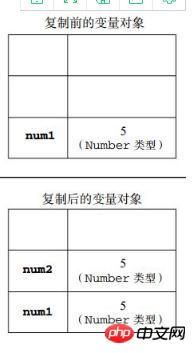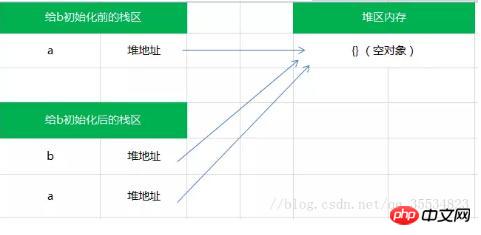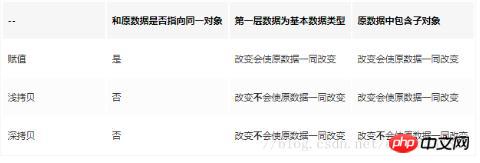Home >Web Front-end >JS Tutorial >js implements deep and shallow copy method
js implements deep and shallow copy method
- 小云云Original
- 2018-03-16 16:44:022780browse
Speaking of deep and shallow copying, I think we need to clarify value types and reference types. This article mainly shares with you the js implementation of deep and shallow copying methods, hoping to help everyone.
Value type
The so-called value type is undefined, null, number , string, boolean and other five basic data types, there should also be a Symbol type.
Value type data is stored in stack memory
Modifying the value in value type is equivalent to opening a new one in stack memory The storage space is similar to:

Explained in code:
var num1 = 5var num2 = num1
The value of the value type cannot be changed
There is a fundamental difference between primitive values (undefined, null, Boolean values, numbers and strings) and objects (including arrays and functions) in JavaScript. Primitive values are immutable: no method can change (or "mute") a primitive value. This is obviously true for numbers and booleans - changing the value of a number itself doesn't make sense, but it's less obvious for strings, because strings look like arrays of characters and we expect to be able to specify the index by to modify characters in a string. In fact, javascript prohibits this. All methods in string appear to return a modified string, but actually return a new string value.
var str = 'abc'str[0] = 'd'console.log(str) // 'abc'
The comparison of value types is the comparison of values
The comparison of value types is the comparison of values. As long as their values are equal, they are considered equal
var a = 1;var b = 1;console.log(a === b);//true
Reference type
Reference type data is stored in heap memory
Reference type value is stored in heap memory, and the variable stores a value stored in stack memory , a pointer to heap memory.
var person1 = {name:'jozo'};var person2 = {name:'xiaom'};var person3 = {name:'xiaoq'};
The value of a reference type can be changed
The reference type can directly change its value
var a = [1,2,3]; a[1] = 5; console.log(a[1]); // 5
The comparison of reference types is the comparison of references
So every time we operate on the reference type in js, we operate on the reference of its object (the pointer saved in the stack memory), so compare the two The reference type depends on whether its references point to the same object.
var a = [1,2,3];var b = [1,2,3];console.log(a === b); // falsevar a = [1, 2, 3]var b = aconsole.log(a === b) // true
Passing by value and passing by address
After understanding the difference between basic data types and reference types, we should be able to understand the difference between passing by value and passing by address.
When we perform an assignment operation, the assignment (=) of the basic data type is to open a new stack memory in the memory, and then assign the value to the new stack
var a = 10;var b = a; a ++ ; console.log(a); // 11console.log(b); // 10

So, the two variables assigned by the basic type are two independent variables that do not affect each other.
But the assignment of reference types is by address. Just change the pointer pointing, for example, that is to say, the assignment of the reference type is the assignment of the address of the object stored in the stack. In this case, the two variables point to the same object, so the operations between the two affect each other.
var a = {}; // a保存了一个空对象的实例var b = a; // a和b都指向了这个空对象a.name = 'jozo';
console.log(a.name); // 'jozo'console.log(b.name); // 'jozo'b.age = 22;
console.log(b.age);// 22console.log(a.age);// 22console.log(a == b);// true
Shallow copy

##Implementation:
function shallowCopy (src) {
let new = {} for (let i in src) { if (src.hasOwnProperty(i)) { new[i] = src[i]
}
} return new}Deep copy One kind of cool operation is to use JSON.parse and JSON.stringifyvar a = {
name: 'SpawN',
age: 28}var b = JSON.parse(JSON.stringify(a))
b.name = 'Johnny.R'console.log(a.name) // 'SpawN'The other is a professional operation, which is a regular operation, which is to use recursion to traverse all attributes under the target object function deepCopy(obj) {
if (typeof obj !== 'object') return
// 初始化
var newObj = obj instanceof Array ? [] : {} for (let k in obj) { if (obj.hasOweProperty(k)) {
newObj[k] = typeof obj[k] === 'object' ? agruments.callee(obj[k]) : obj[k]
}
} return newObj
} This is only a basic deep copy, and some boundaries are not properly handled. The basic idea is to use the for in loop. When the value is an object, the for in loop is recursively performed. Related recommendations:
Detailed explanation of deep and shallow copies of js arrays and objects
How to implement deep and shallow copies of arrays and objects
Introductory Tutorial on Deep and Shallow Copy: 10 Recommended Zero-Based Introductory Tutorials on Deep and Shallow Copy
The above is the detailed content of js implements deep and shallow copy method. For more information, please follow other related articles on the PHP Chinese website!
Related articles
See more- An in-depth analysis of the Bootstrap list group component
- Detailed explanation of JavaScript function currying
- Complete example of JS password generation and strength detection (with demo source code download)
- Angularjs integrates WeChat UI (weui)
- How to quickly switch between Traditional Chinese and Simplified Chinese with JavaScript and the trick for websites to support switching between Simplified and Traditional Chinese_javascript skills

